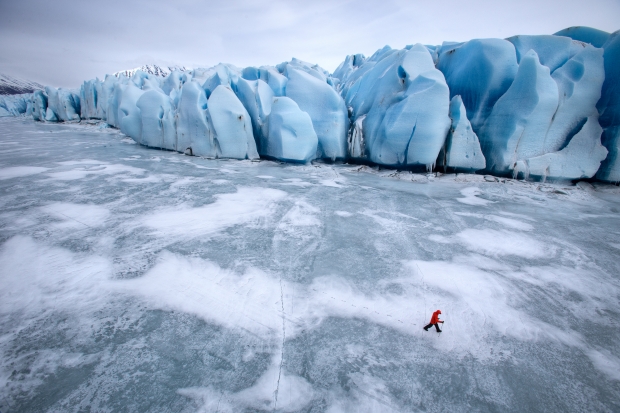
One of many scouting trips for the planned expedition…Photo Jody MacDonald
I am planning the most ambitious bivvy expedition of my life this spring. A full traverse (from west to east) of the massive and seriously remote Alaska Range. Straight line it’s just shy of 500 miles. I anticipate it will take as long as 8 weeks. I’m going to do it fully unsupported- so once I get dropped off, I’m on my own until I finish or have to bail (or worse!). I’ll be putting in food caches in advance every 100 kilometers or so which will make planning and logistics pretty critical. If I’m having a good day do I fly over a cache and blow it off and risk going without food for many days, or do I land, get the food and miss precious time in the air making distance? In May and June in the alpine there isn’t much to eat other than ground squirrels. Down low the salmon aren’t high enough in the rivers and the bears are hungry so I need to stay high.
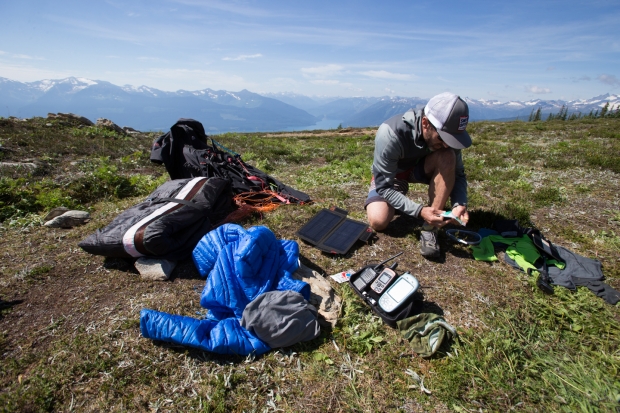
On Day 9 of the Rockies Traverse you start figuring out what belongs and what doesn’t!
This post is a follow up to an earlier gear post I wrote about the kit Will Gadd and I carried on the Rockies Traverse, the things we carried and hopefully answers many questions I’ve been getting about what’s critical and what’s not. I actually haven’t changed much but it has been refined and I’ve been able to cut more than 10 pounds of weight which is considerable. Here’s the most important stuff in my bag these days for extended bivvy trips. If you would like to download the complete list, go here.
- Wing: Niviuk Peak 4 “P” Series, which comes from the DNA of the Icepeak 6 which in my opinion is the best two-line glider ever made, and the I’m thrilled to fly it’s light-weight cousin. Intense, exciting, built for adventure, and with an insatiable appetite for kilometers, it has an enormous potential for endless exploration anywhere on the planet. For bivvy flying your wing should be something you are deeply familiar with and comfortable putting into tight spots. Many people question whether a two-liner is an appropriate bivvy wing, and this just depends on the pilot. I prefer to have bar performance and being on a wing that can handle wind, but for me is still very safe and stays inflated in turbulent air. In my opinion you shouldn’t be bivvy flying if you aren’t really comfortable in dicey conditions, and aren’t an ace with ground handling and top-landing so commenting about wing choice isn’t really appropriate for this blog post. Choosing a light-weight wing over a standard wing however is appropriate. For the Rockies Traverse both Will and I chose a regular wing as we wanted the durability. For Alaska I’m planning on staying in the Alpine, hopefully there will still be plenty of snow and I need to be light and nimble on the ground as there are going to be some monster moves on the ground so I’ve chosen the lighter wing.
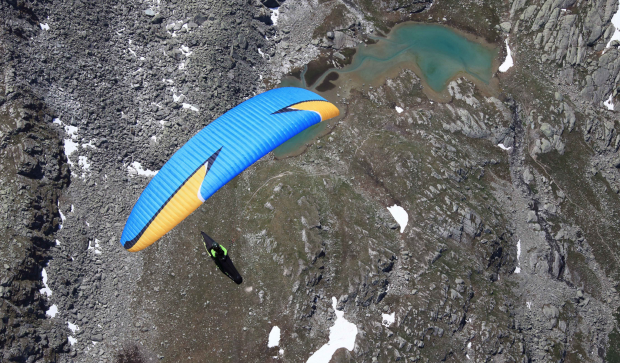
Niviuk Peak 4
- Sup’Air Delight 2 harness. I’m really excited this latest pod harness from Sup’Air. For bivvy flying you want light but you want durable and you need space. The Delight has it all, but just. Remove the seat plate and padding and it weighs less than 3 kilos. Plenty of space for your tent, sleeping bag, food, emergency kit, stove and other gear. Light-weight backpack with all the necessary adjustments.
- Delorme InReach two-way communications and tracking device. This little piece of kit is right at the top because it’s the most important thing I carry. In Alaska there is no cell service and the InReach is my only way to communicate with the outside world. AND- the outside world will know exactly where I am at all times. You have the choice of SPOT or InReach these days and if you want my full opinion on which to choose, read my review of differences here.
- Black Diamond I-Tent (Bibler series). At 1.95 kg this is the lightest, most bomb-proof tent on the market that I know of. I used to use a bivvy sac, and that still works if you aren’t going to be dealing with much weather, but if rain and wind and cold are likely, as they will be in Alaska a tent is paramount to safety and comfort- and keeping your gear dry.
- Electronics: Suunto Ambit Peak 3 watch and heart rate monitor (to track my metrics and also serves as back-up log); Yeasu VX-3 radio (lightest and smallest that I know of); XCTracer vario and Iphone (eliminates a standard vario. Tiny and weighs a couple ounces and creates and igc log and pairs via bluetooth to the phone); NOCO XGrid 12K mAh spare battery and 14 watt solar panel. I haven’t found anything less than 12000 mAh batteries to be big enough to handle keeping a phone and other electronics charged, and anything less than a 14 watt panel fast enough to charge. As I’ve written about many times, the only Push to Talk system I trust and find works reliably is the Thermal Tracker.
- Clothing. This is of course totally dependent on where you’ll be flying, but for me Patagonia’s Houdini jacket, Patagonia’s Nano-air jacket (light, breathable, WARM and packable), wool long underwear tops and bottoms, wool socks, beanie, buff, and bombproof shoes like the Salewa Speed Ascent are all a must.
- Klymit sleeping pad. I’ve made this it’s own category because sleeping is important and weight is critical and Klymit’s inflatable stripped-down high tech pads are perfect. The Inertia X-Lite comes in at a remarkable 6.1 ounces!
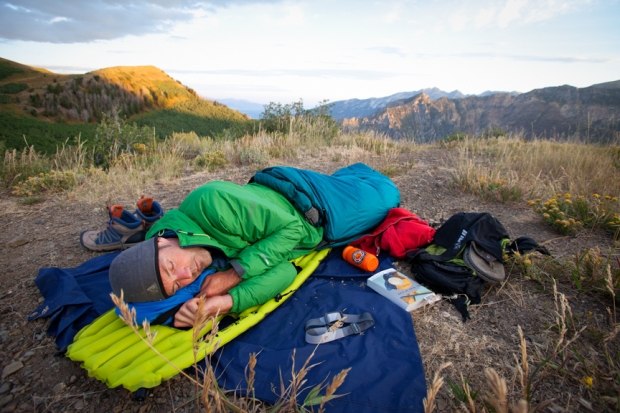
- Other important gear: bug spray; bear spray (if you’re in bear country!); repair kit (speedy stitcher, fabric, spare lines, needle, scissors, glue, tape, seam grip); helmet (I use the Smith Maze because it is so light but still warm); sunglasses (Smith Pivlocks are CHOICE!); gloves (light and heavy); Dromedary (and a Steripen if you need to filter your water); hiking poles; sunblock; blister-kit; Sleeping bag (down); Leatherman or multi-tool; dop-kit (toothbrush, etc.); Stove and fuel (I like the Jetboil), lighter, food bag, dehydrated coffee; and camel back.
- Food. Food is CRITICAL to happiness and success. Shit food is where a lot of expeditions fail. In each of my resupply caches I’ll have a healthy stack of pretty much everything Patagonia Provisions makes because it’s delicious, light-weight, SUPER healthy, organic and sustainable- smoked salmon, energy bars, buffalo jerky, and their amazing Tsampa soups. And of course coffee, sugar, and treats!
Please let me know if you have your own tricks for bivvy flying in regards to gear and if I’ve left anything out. Fly far, fly safe, and have fun!


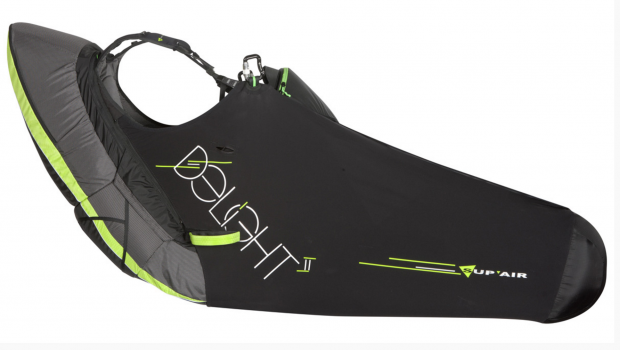



We love the klymit sleeping mats for our travels. How about the solar panel? We are traveling with one but when walking or flying we found it’s hard to position it optimal so it charges the battery. And hanging around camp for hours when the sun is out doesn’t seem to be a option as you want to get somewhere…
Hey Moritz. I too find it very hard to use the panels while underway. You really need down time. I’ve seen people fly with them on the outside of their harness but I don’t like misc junk hanging off me. Unfortunately I also find I need at least a 14 watt panel, which isn’t small…or very light. I’m working closely with Noco/XGrid on developing this tech.
I’m currently testing this.. 16 watt folding panel that lies flat on your pod, velcro technology! 12.5 ounces or 350 grams made by suaoki, cheap and cheerful, but working fine in our UK winter sun. ill keep you posted on progress
hers a link
http://www.ebay.co.uk/itm/16W-Folding-Solar-Power-Charger-Panel-External-Battery-For-Mobile-Phone-Camping-/252021893932?hash=item3aadaceb2c:g:qQYAAOSwLVZVnhQE
Thanks Barney! Keep me posted.
Hi Barney, so is the plan to power your instruments directly when flying, or charge up a spare battery when flying, leaving your instruments and phone if you’re using FlySkyHy / XCSoar say, running off another battery?
Cheers, Tim
Hey Tim, sorry not sure why I called you Aaron in the last! I don’t find charging while flying works very well. I charge as much as possible morning and evening, and days that are unflyable and carry a pretty large external battery (I use the Noco 12000mAh battery). So when I’m flying I keep my phone plugged into the battery. When I’m down I charge my XCTracer (vario), InReach, and phone again if needed.
I don’t see a 14W panel that’s available from NOCO. 9W yes, but 14W no. Is that a product in development?
Hey Amir. Sorry, meant 9. I’ll change that. The 5 watt panel was not strong enough.
I love my Klymit Ineria X-Lite. It’s great for camping, but I also use it in my car while driving, to keep my back from getting sweaty on leather seats.
I was considering the flynet product paired with flyskyhy on the iPhone for next season. How did you arrive at the xctracer, and what are you feeding it to on your iPhone? I understand you are running the iPhone off external power. Even so when you are high and it is cold, you don’t have a problem with the phone getting too cold and shutting down? Thanks for the read.
Hey Aaron,
Tom Sliepen set me up with the XCTracer as he’s working with the guys in Europe. And- Josh Cohn as well as Joel Debbons had them at US Nationals so I figured it must be good. I haven’t paired it yet with my phone (I just switched to an Iphone so in mexico stayed with XCSoar on Android as I didn’t want to have to learn something new for the comp). But I have looked at FlySkyHy and it looks great. I run the phone always connected to a 12 mAh battery (I use a Noco like in the article) and when I’m bivvy flying I keep a 14 watt panel with me. Cold doesn’t seem to affect it, even when I’m up really high (except I’m sure chewing through more battery).
Cheers!
Hi Aaron, I use FlySkyHy on my iPhone 6 using a 13000mAh Anker battery. If I connect it to the 1A output the iPhone will shut down if it’s cold, but the 2A output works fine in all conditions that I’ve flown in.
HTH
Tim
PS. I’ve got the XCTracer too – love it!
Have you thought about the BioLite stove rather than the Jet Boil? http://www.amazon.com/BioLite-BL-CSA-Wood-Burning-Campstove/dp/B00BQHET9O
As much as I like the Jet Boil it isn’t always great at altitude and it’s a pain if you run out of fuel. With the BioLite you get your fuel on route and you can charge devices using the USB. Dual purpose equipment is always important when you have to carry it!
Hey Garrick, I’ll check this out! Thanks!